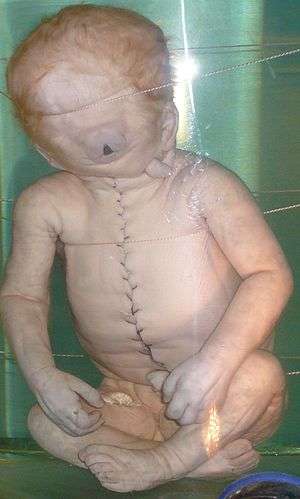Cyclopia
Cyclopia (also cyclocephaly or synophthalmia) is the most extreme form of holoprosencephaly and is a congenital disorder (birth defect) characterized by the failure of the embryonic prosencephalon to properly divide the orbits of the eye into two cavities. Its incidence is 1 in 16,000 in born animals and 1 in 200 in miscarried fetuses.[1][2]
| Cyclopia | |
|---|---|
 | |
| Specialty | Medical genetics |
Presentation
Typically, the nose is either missing or replaced with a non-functional nose. This deformity (called proboscis) usually forms above the center eye or on the back, and is characteristic of a form of cyclopia called rhinencephaly or rhinocephaly.[3] Most such embryos are either naturally aborted or are stillborn upon delivery.
Although cyclopia is rare, several cyclopic human babies are preserved in medical museums (e.g. The Vrolik Museum, Amsterdam, Trivandrum Medical College).[4]
Some extreme cases of cyclopia have been documented in farm animals (horses, sheep, pigs, and sometimes chickens). In such cases, the nose and mouth fail to form, or the nose grows from the roof of the mouth obstructing airflow, resulting in suffocation shortly after birth.[5]
Causes
Genetic defects or toxins can misdirect the embryonic forebrain-dividing process.[6] One highly teratogenic alkaloid toxin that can cause cyclopia is cyclopamine or 2-deoxyjervine, found in the plant Veratrum californicum (also known as corn lily or false hellebore). Grazing animals are most likely to ingest this plant and induce cyclopia in offspring. The mistake of humans ingesting Veratrum californicum while pregnant is often due to hellebore, an unrelated plant with the same name, being recommended as a "natural" treatment for vomiting, cramps, and poor circulation, three conditions which may be present in the early stages of pregnancy.[7] Cyclopia occurs when certain proteins are inappropriately expressed,[8] causing the brain to stay whole, rather than developing two distinct hemispheres. This leads to the fetus having one optic lobe and one olfactory lobe, resulting in the eye and nose malformations of cyclopia.[9]
The Sonic Hedgehog (SHH) gene regulator is involved in the separation of the single eye field into two bilateral fields.[10] Although not proven, it is thought that SHH emitted from the prechordal plate suppresses Pax6, which causes the eye field to divide into two. If the SHH gene is mutated, the result is cyclopia, a single eye in the center of the face (Gilbert, 2000).
Notable cases
- A British description from 1665 of a colt apparently suffering from cyclopia reads:
First, That it had no sign of any Nose in the usual place, nor had it any, in any other place of the Head, unless the double Bagg CC that grew out of the midst of the forehead, were some rudiment of it. Next, That the two Eyes were united into one Double Eye which was placed just in the middle of the Brow.[11]
- On 1 March 1793, a 46-year-old woman in Boalts Torp, Glimåkra, Sweden gave birth to a child with cyclopia that died after 2 hours. The child was 35 cm long, its face without nose and nostrils, and its lidless eye with no eyebrow sat raised on the middle of its forehead like a large blueberry. The wrists were somewhat crooked as well as the right foot which was completely crooked and bent inwards. It was not clear whether it was a boy or a girl, but it was believed to be the former.[12]
 A Swedish description from 1793 of a newborn with cyclopia
A Swedish description from 1793 of a newborn with cyclopia - On December 28, 2005, a kitten with cyclopia, "Cy", was born in Redmond, Oregon, United States and died about one day after birth.[13]
- In 2006, a baby girl in India with cyclopia was born. Her only eye was in the center of her forehead. She did not have a nose and her brain did not separate into two separate hemispheres (holoprosencephaly).[14] The child died one day after her birth.[15]
- In 2011 a cyclops shark fetus was discovered in the body of a caught shark in Mexico, with no discernible nose and one giant eye. The unborn fetus was turned over for medical studies.[16]
- On October 10, 2012, a small kitten was born. Its eye was in the center of the forehead and there was no developed nose to be found. The small cat died shortly after it was born. It was nicknamed Cleyed the Cyclops.[17]
- On May 10th, 2017, in Assam, India, a black goat was born with one eye and other cyclopia-related facial abnormalities. It was reported to still be alive over a week later, which is unusual for this condition. [18]
- On September 13th, 2018, in Mandailing Natal, North Sumatera, Indonesia, A baby with cyclopia was born without a nose and one eye with the weight of 2.4 kg (5.3 lb) and heart rate under 100 bpm. The child died seven hours after birth.[19]
See also
- Hedgehog pathway
- Cyclopes
References
- Taber's Cyclopedic Medical Dictionary, ISBN 0-8036-0654-0
- Leroi, Armand Marie Mutants: On Genetic Variety and the Human Body, p.73. ISBN 978-0142004821
- Dark, Graham (2007). Rhinocephaly. In Online Medical Dictionary. Retrieved July 23, 2008.
- "Vrolik Museum, Department of Anatomy And Embryology, University of Amsterdam". Archived from the original on 2007-12-08.
- "Feline Medical Curiosities: Facial Deformities". Messybeast.com. 2007. Retrieved 2008-11-29.
- "Cyclopia definition". Medical Dictionary. MedTerms. Retrieved 2008-11-29.
- "Teratology Society".
- Erich Roessler; Elena Belloni; Karin Gaudenz; Fernando Vargas; Stephen W. Scherer; Lap-Chee Tsui & Maximilian Muenke (1997). "Mutations in the C-terminal domain of Sonic Hedgehog cause holoprosencephaly" (PDF). Human Molecular Genetics. 6 (11): 1847–1853. doi:10.1093/hmg/6.11.1847.
- Chin Chiang; Ying Litingtung; Eric Lee; Keith E. Young; Jeffrey L Corden; Heiner Westphal; Philip A. Beachy (1996). "Cyclopia and defective axial patterning in mice lacking Sonic hedgehog gene function". Nature. 383 (6599): 407–413. doi:10.1038/383407a0. PMID 8837770.
- Carlson, Bruce (2014). Human Embryology and Developmental Biology (5th ed.). Elsevier. p. 309. ISBN 978-1-4557-2794-0.
- "Observables upon a Monstrous Head". Philosophical Transactions of the Royal Society. 1 (5): 85–86. 3 July 1665. doi:10.1098/rstl.1665.0037. JSTOR 101436.
- Volume 1 – 1666 at Project Gutenberg
- "Födde" [Birth]. Kyrkbok [Parish Register]. 1752–1800 (in Swedish). CI:3. Glimåkra. 1793. pp. 174–175.
- Petty, Terrence (January 11, 2006). "Not a Hoax, One-Eyed Kitten Had Bizarre Condition". Animaldomain. LiveScience.com. Archived from the original on 2006-02-03. Retrieved 2014-03-07.
- "Cyclops Baby". Oddee. 2008-02-28. Retrieved 1 October 2012.
- "Cyclops Baby Born in India Only Survives 1 Day". AOL News. Archived from the original on 19 September 2012. Retrieved 1 October 2012.
- "Pictures: Rare "Cyclops" Shark Found". News.nationalgeographic.com. 2011-10-13. Retrieved 2014-03-07.
- "Viewers pitied Cleyed, the one-eyed kitten".
- MAHBOUBIAN-JONES, J. (2017). 'Cyclops goat' born in Indian village. Retrieved from http://www.digitalspy.com/tech/news/a829042/cyclops-goat-born-in-india-2/
- "Bertahan Hidup 7 Jam, Bayi "Cyclopia" Hembuskan Nafas Terakhir". 2018-09-14.